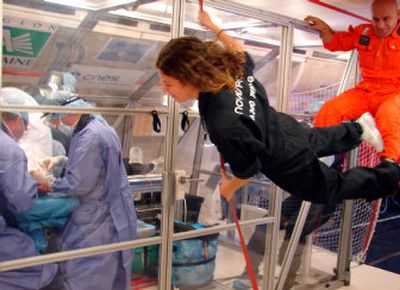Doctors operate in zero gravity

MERIGNAC, France – Braving queasy stomachs, a team of French doctors took to the skies Wednesday for the first operation on a human in zero-gravity conditions, removing a cyst from the arm of a man as the aircraft soared and dived to create weightlessness.
The five-man medical team made history by slicing off the yellow growth that floated away from the patient, tied to a string. Doctors worked in intervals of 22 seconds during conditions of weightlessness. Coincidentally, it took 22 intervals to complete the surgery.
The operation, more than three years in the making and part of a three-phase exploration of weightless surgery, paves the way toward one day performing surgery in space via a surgeon or a remotely controlled robot. It also is an experiment that may one day be instructive for a future medical emergency on the International Space Station.
The flight lasted three hours, but the operation took just over eight minutes – about the same amount of time that such surgery would have taken in a hospital, doctors said.
Three surgeons, two anesthetists and a cameraman were strapped to the walls with mountain-climbing gear as the aircraft dipped and soared in roller coasterlike parabolas to achieve intervals of weightlessness.
“We have done a simple technical procedure, but everything we noticed shows that operating on a human in space conditions will not present insurmountable problems,” said Dr. Dominique Martin, leader of the medical team.
The surgery went “exactly as we had expected,” he told reporters.
Patient Philippe Sanchot – chosen because he is an avid bungee jumper, hardened to the shocks of G-force strains – was given a local anesthetic and remained awake throughout the operation.
“I’m just a little tired, but it’s because my head is spinning,” Sanchot, 46, said.
The relatively minor procedure was meant to give a preliminary idea of what surgery in space might be like, providing information about how blood flows in zero gravity or whether special equipment was needed.
In the experiment, the plane flew loops 20,000 feet to 27,560 feet over the southwestern city of Bordeaux. The pilot of the specially designed 330 Zero G aircraft cut back the engines at the peak of a climb, allowing near-weightless drift downward. After a near nose-dive, the pilot soared upward at angles of up to 45 degrees.
The surgical team was forced to work quickly: the effect of weightlessness came in brief intervals, with waits and battles with nausea in between.
“I’m not crazy about these parabolic flights. While it’s an extraordinary sensation, I don’t do this for fun,” Martin said. “In the last parabolas, I felt a bit of gastric reflux.”
Doctors acknowledged the relatively minor excision was a far cry from more complicated surgery that could be needed on the space station, but suggested it was an important first step.
Martin said there was no telling what kind of operations were best suited for weightless conditions.
“If I had two hours of weightlessness, I could have removed an appendix – or whatever – but we had 10 minutes to show an operation was possible in these conditions,” he said.
The operation was the second of a three-phase analysis of medical procedures in near-weightless conditions. In the first, Martin and his team performed microsurgery on a rat’s tail in a similar flight in 2003 – an operation far more complex than Wednesday’s.
Martin declined to discuss phase three, which will test zero-gravity procedures carried out by a robot controlled from the ground. If funding permits, that test could happen next year, he said. The operation was supported by the French National Center for Space Studies and the European Space Agency.